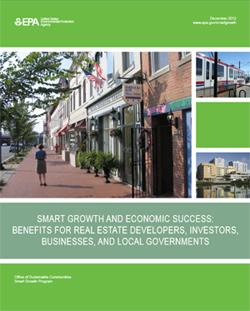
Smart Growth and Economic Success: Benefits for Real Estate Developers, Investors, Business, and Local Governments (2012) is the first in a series of reports designed to inform developers, businesses, local government, and other groups about the benefits of smart growth development. This report incorporates feedback from a 2011 workshop in which business leaders, real estate developers, and economic development professionals discussed how to expand on work in this area.
Some of the advantages for developers, communities, and local governments associated with smart growth include:
- Compact development: Compact development can generate more revenue per acre because it uses land more efficiently. It can reduce the costs of land and infrastructure for individual projects and the costs of providing public services and amenities. Locating companies close together can create a density of employment that increases economic productivity and attracts additional investment.
- Walkability: Projects in walkable neighborhoods command a price premium, earning real estate developers and investors a higher return on investment. Neighborhoods that are more appealing to pedestrians can attract customers to local businesses, which benefits local governments by generating more property and sales tax revenue.
- Range of choices: The demand for homes in smart growth neighborhoods exceeds the supply. Changing demographics will likely further increase the demand for smart growth development. Developers, investors, businesses, and local governments that respond to these market preferences could reap economic advantages.
The other reports in the series delve into more detail:
- Smart Growth and Economic Success: The Business Case (2013) discusses how locations with housing and transportation options, a mix of uses close together, and a high quality of life can improve environmental outcomes while providing economic advantages for businesses.
- Smart Growth and Economic Success: Investing in Infill Development (2014) discusses how barriers to infill development that discourage developers are not only often surmountable, but also are beginning to diminish as infill development becomes more common.
- Smart Growth and Economic Success: Strategies for Local Governments (2014) discusses smart growth approaches local governments can use to lower costs and/or increase revenue.
